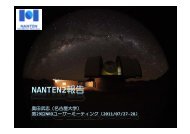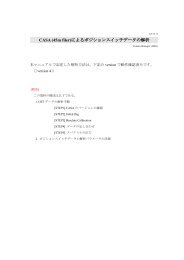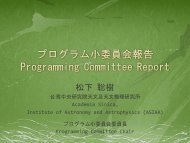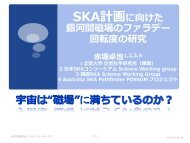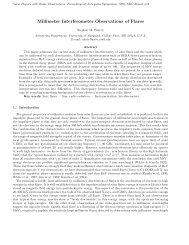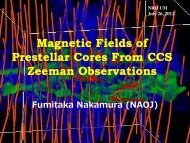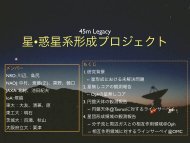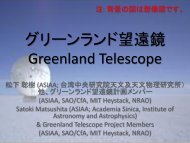Physics of the Solar Active Regions from Radio Observations
Physics of the Solar Active Regions from Radio Observations
Physics of the Solar Active Regions from Radio Observations
Create successful ePaper yourself
Turn your PDF publications into a flip-book with our unique Google optimized e-Paper software.
50 G. GelfreikhFig. 10.. Variations <strong>of</strong> <strong>the</strong> structure <strong>of</strong> a polarized source during <strong>the</strong> three-minute oscillations. (<strong>Observations</strong> were made with <strong>the</strong>Nobeyama radio heliograph).The first problem uses two approaches to get a 3D picture <strong>from</strong> observed 2D pictures: stereoscopic analysis <strong>of</strong> astable ARfor several dates (see Aschwanden 1995, and Figure 4).The second method uses solution <strong>of</strong> equation <strong>of</strong> transfer to find longitude distribution, both <strong>of</strong> <strong>the</strong> magnetic fieldand temperature, density <strong>of</strong> <strong>the</strong> plasma (Grebinskij, 1999, this proc.).7. Future DevelopmentNow we summarize some problems to be considered in <strong>the</strong> near future using <strong>the</strong> observations <strong>of</strong> <strong>the</strong> Nobeyamaradioheliograph.1. I would like to stress <strong>the</strong> importance <strong>of</strong> studying activity in polar active regions as part <strong>of</strong> <strong>the</strong> global activity <strong>of</strong><strong>the</strong> sun. That implies importance to compare at each step <strong>the</strong> level and peculiarity <strong>of</strong> active regions near <strong>the</strong> poles(polar faculae) and <strong>the</strong> “classical” low-latitude ARs. We have got already <strong>the</strong> observations at declining phase <strong>of</strong> <strong>the</strong>previous (22-nd) cycle, <strong>the</strong> growth phase <strong>of</strong> <strong>the</strong> present (23-rd) cycle and its maximum is not so far away. We stillmay have a hope to use <strong>the</strong> Nobeyama radioheliograph to analyze <strong>the</strong> behavior <strong>of</strong> <strong>the</strong> polar magnetic fields, bothusing chromospheric structures and possibly still polarization effects (though very weak ones).2. In analyzing <strong>the</strong> three-dimensional structures <strong>of</strong> <strong>the</strong> magnetospheres <strong>of</strong> <strong>the</strong> solar ARs only some first, but verypromising steps have been made. Above we discussed some promising methods to restore 3D-structure <strong>of</strong> magneticfields in strong and weak ARs, accessible both on <strong>the</strong> chromospheric and coronal levels <strong>of</strong> <strong>the</strong> solar atmosphere.Both stereoscopic and tomography (solution <strong>of</strong> <strong>the</strong> equation <strong>of</strong> radiation transfer) methods are to be used.3. Studying <strong>the</strong> physical processes representing <strong>the</strong> transfer, accumulation and release <strong>of</strong> non<strong>the</strong>rmal energy(leading both to hot <strong>the</strong>rmal corona and evidently non<strong>the</strong>rmal flare and mass-ejecting events). At this stage weshould develop <strong>the</strong> methods <strong>of</strong> studying 3-minute, 5-minute oscillations detected at Nobeyama above sunspots.However, we have some preliminary results (see e.g. polar faculae at Figure 3) showing that we have tools toinvestigate plasma oscillations (plasma turbulence) in many structures at λ =1.76 cm.8. AcknowledgementsThe author thanks <strong>the</strong> support to some <strong>of</strong> <strong>the</strong> results presented in this paper by RFBR, GRANT 96-02-16268aand Russian program “Astronomy”, grant 1.5.4.6. Especially he feels thankful to <strong>the</strong> staff <strong>of</strong> <strong>the</strong> Nobeyama <strong>Radio</strong>Observatory for possibility to work with <strong>the</strong> radioheliograph observations.ReferencesAbramov-Maximov V.E., Vyalshin G.F., Gelfreikh G.B., Shatilov V.I. 1996, SolPhys 164, 333Akhmedov, Sh.B., Borovik V.N., Gelfreikh G.B., Bogod V.M., Korzhavin A.N., Petrov Z.E., Dikij V.N., Lang K.R., WilsonR.F. 1986, ApJ 301, 460Akhmedov Sh.B., Gelfreikh G.B., Bogod V.M., Korzhavin A.N. 1982, SolPhys 79, 41



